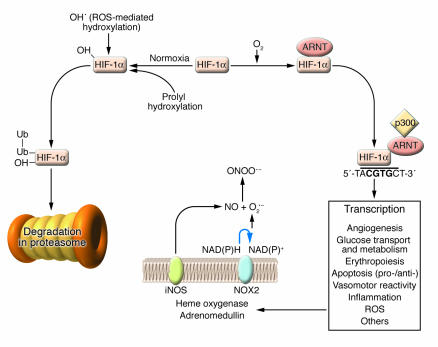Figure 3.
Transcriptional gene regulation by the hypoxia-inducible factor HIF-1α. HIF-1α protein undergoes rapid prolyl hydroxylation under normoxic conditions by specific cellular prolyl hydroxylases. Direct hydroxylation by ROS is a purported alternative pathway. Hydroxylated HIF interacts with the VHL, a critical member of an E3 ubiquitin ligase complex that polyubiquitylates HIF (Ub, ubiquitin). Polyubiquitylation targets HIF-1α for destruction by the proteosome. Under hypoxia (¬O2) hydroxylation does not occur and HIF-1α is stabilized. Heterodimerization with ARNT forms the active HIF complex that binds to a core hypoxia response element in a wide array of genes involved in a diversity of biological processes germane to cardiovascular function. Transcriptional activation of iNOS expression is shown as an example of how HIF-mediated gene expression can affect ROS generation by generating NO that interacts with O2–– to form ONOO––. NOX2 is shown as a cellular source of O2––.

